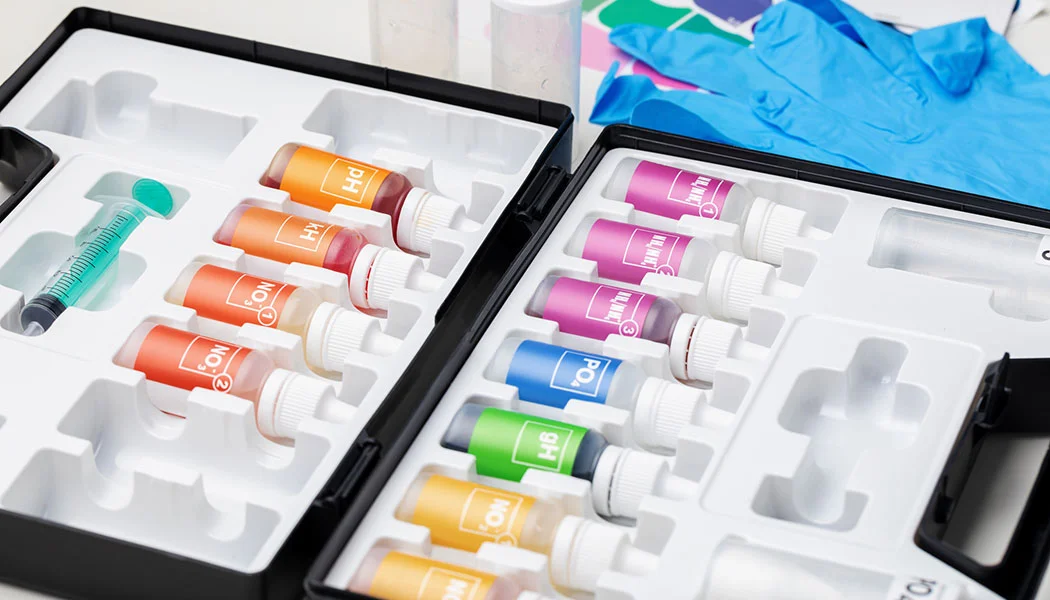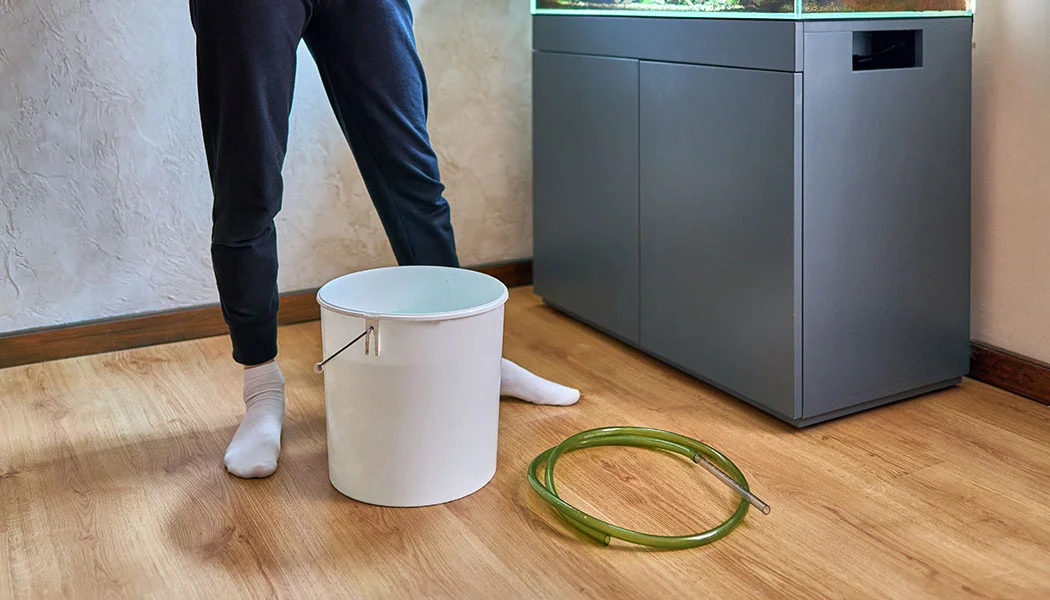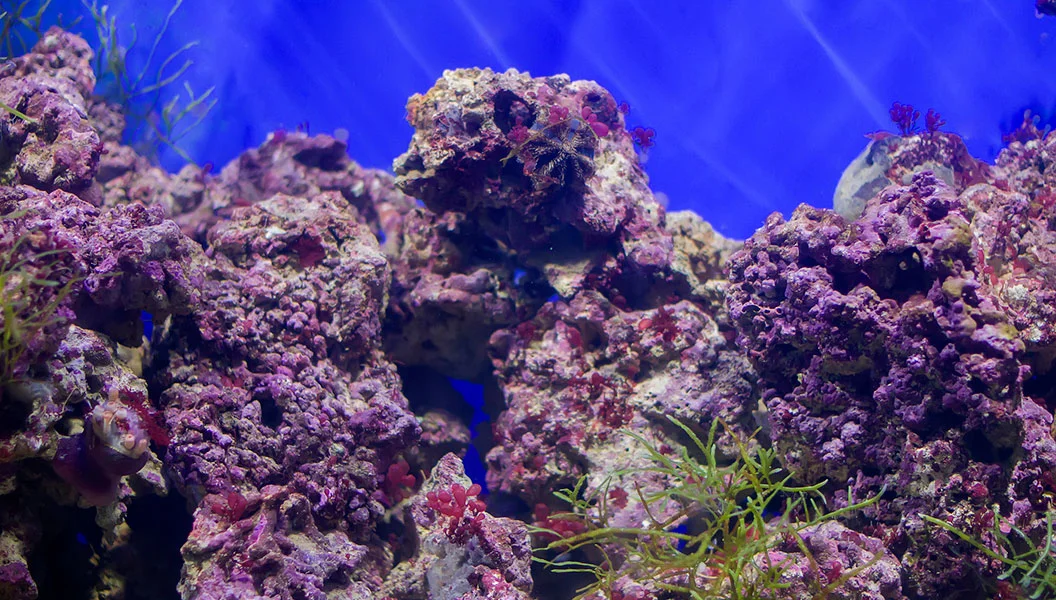Maintaining low nitrate levels in saltwater aquariums is one of the biggest challenges.
As I learned when battling the relentless nuisance algae in my system. I tried everything from water changes to scrubbing it with a toothbrush. I finally found a balance in my water chemistry.
This article will guide you through nitrate management methods. We’ll talk about biological filtration, carbon dosing, and proper feeding strategies. You’ll also learn why nitrates can harm corals and how to keep them in the ideal range for your tank type.
Table of Contents
Key Takeaways
- Nitrates are byproducts of fish waste and decaying matter.
- High levels can stress marine life and promote algae growth.
- Regular testing and maintenance are essential to keep nitrates low.
- Multiple methods, like water changes and biological filtration, can help keep nitrates under control.
Understanding Nitrates in Reef Tanks
Nitrates are a natural byproduct of the nitrogen cycle. Essential for maintaining balance in aquariums but harmful at high levels.
Formed through the breakdown of fish waste, uneaten food, and decaying matter. Nitrates can accumulate if not managed effectively. The nitrogen cycle converts toxic ammonia into nitrites and then nitrates. This process ensures the detoxification of waste.
Elevated nitrates can stress saltwater fish, harm corals, and fuel algae. Understanding how nitrates are formed through the nitrogen cycle, will help you maintain a healthy reef tank.

What Are Nitrates and Where Do They Come From?
Nitrates are a byproduct of the nitrogen cycle, a critical process in any aquarium. They form when beneficial bacteria break down fish waste, uneaten food, and decaying organic material. This process converts toxic ammonia (NH₃) into nitrites (NO₂) and finally into nitrates. This becomes less harmful but still poses risks at high concentrations.
Fish waste is one of the primary contributors to nitrates. When fish excrete waste, it releases ammonia into the water, triggering the nitrogen cycle. Uneaten food also decomposes over time, adding to the organic load. Plants and algae that die off contribute to this cycle. As their decaying material is processed by bacteria, it releases nitrates.
Low nitrate levels are vital for maintaining healthy aquatic life in marine environments. High nitrates can cause stress. This can cause reduce coral growth rates and harm sensitive species like invertebrates.
The Nitrogen Cycle and Its Role in Aquariums
It starts with ammonia, produced by fish waste, uneaten food, and decaying matter. Beneficial bacteria, Nitrosomonas, convert ammonia into nitrite, another harmful compound. Nitrite is then broken down by a second type of bacteria, Nitrobacter. This creates nitrate, which is less toxic but still requires management.
The cycle ensures the detoxification of waste, making the water safe for your fish.
Without this process, ammonia and nitrite levels would quickly reach toxic levels. This will endanger all tank inhabitants. A properly cycled aquarium relies on a balance of these bacteria.
New tanks need time to establish the nitrogen cycle. Fully established systems can efficiently process waste. However regular maintenance is crucial to prevent disruptions in the cycle.
Why High Nitrate In A Reef Tank Are Harmful
High nitrates in saltwater aquariums can be harmful to corals, fish, and invertebrates.
High nitrate levels have a negative impact on fish. They can cause stress, weaken immune systems, and slow down growth. This poses a real problem for fish that do well in waters with few nutrients. Clownfish and gobies are examples of such sensitive species.
Corals are especially vulnerable to high nitrates. While soft corals may tolerate moderate concentrations. Hard corals, like SPS (small polyp stony) corals, need extremely low levels to survive. High nitrates can cause tissue degradation, reduced coloration, and stunted growth in corals.
Excessive nitrates also promote algae blooms. Algae feed on nitrates, causing rapid growth, and compete with corals for nutrients. Algae can quickly take over the tank.
Reduce Nitrate Levels in Saltwater Aquarium
Testing nitrates regularly helps ensure they stay within safe ranges for reef tanks.
Water changes, filtration, carbon dosing, and proper feeding are effective ways to control nitrate. By understanding how to implement these techniques, you can prevent nitrate buildup.

Testing and Monitoring Nitrate Levels
Testing nitrate levels regularly should be a part of your regular maintenance.
Various nitrate test kits are available to hobbyists. Salifert and Red Sea are popular choices for accuracy and ease of use. These kits measure nitrate in parts per million (ppm), ensuring levels are within safe ranges.
- Reef tanks: Ideal nitrates are between 1–5 ppm to support coral health.
- Fish only tanks: Can tolerate higher nitrates, up to 40 ppm, without significant harm to fish.
- FOWLR tanks: Nitrate ranges from 10–20 ppm, balancing fish health and live rock benefits.
- Exceeding these limits: Causes stress to marine life and promotes algae growth.
New saltwater aquariums should be tested every two to three days during the cycling process.
Once the tank is stable, testing once a week is enough for most reef tanks. The frequency of testing depends on the tank’s setup and bio-load.
Remove Nitrates with Water Changes
Water changes are the best method for lowering nitrates in a new saltwater aquarium. By removing a portion of the old water and replacing it with new saltwater, you effectively dilute the concentration of nitrates in the tank.
The solution to pollution is dilution
To achieve nitrate reduction, perform water changes of 10% weekly. Heavily stocked tanks or those experiencing high nitrates may require more frequent water changes, such as 20–30%.
Consistency is key: skipping regular changes can lead to nitrate accumulation.

Using RO/DI (Reverse Osmosis/Deionized) water is critical for maintaining water quality. Tap water often contains nitrates and other impurities that can exacerbate the problem. RO/DI water ensures you’re not introducing more nitrates during water changes.
Before adding new saltwater during a water change. Ensure it matches the temperature and salinity of the tank to prevent stress.
Water changes can also replenish essential trace elements. These minerals are consumed by corals and other organisms. This dual benefit makes water changes a cornerstone of aquarium maintenance.
Biological Filtration Methods
Biological filtration is an effective way to manage nitrate levels in saltwater aquariums.
Refugiums are a popular choice, as they house macroalgae like Chaetomorpha or Caulerpa. These algae absorb nitrates as they grow, providing a natural means of removal. Lighting the refugium on an opposite schedule to the display tank also stabilizes pH levels.
Protein skimmers are an essential tool. They remove organic waste before it breaks down into ammonia and nitrites. Removing them beforehand will prevent nitrates from forming.
Live rock and deep sand beds can play a role in the nitrogen cycle. Live rock serves as a home for beneficial bacteria that filter waste into nitrates.
Deep sand beds create an oxygen-free setting. In this environment, certain bacteria break down nitrates. These bacteria turn the nitrates into nitrogen gas. This gas then leaves the water and enters the air above.

Carbon Dosing
Carbon dosing is an effective method for reducing nitrates in saltwater aquariums. By dosing extra carbon it will promote the growth of beneficial bacteria.
Common Carbon Sources:
- Vodka: Popular for its ease of use and precise dosing.
- Vinegar: A milder alternative, suitable for gradual nitrate reduction.
- Commercial products: Pre-mixed solutions like Red Sea NOPOX.
I’ve used Red Sea NOPOX for years and have had great results in control Nitrates.
The carbon process works by stimulating bacteria to multiply and metabolize nitrates. The bacteria will grow and consume excess nutrients. Then it will be removed by the protein skimmer, exporting nitrates from the system.
It is crucial to start with a low dose, such as 0.1 mL per 10 gallons. Then increase the amount while closely monitoring nitrate levels in your saltwater aquarium.
While effective, carbon dosing has risks.
Overdosing can deplete oxygen levels in the tank, potentially harming marine life. Imbalances between nitrates and phosphates may also lead to cyanobacteria outbreaks. A protein skimmer is essential to remove the excess bacteria produced during dosing.
Reducing Feeding
Overfeeding is a major contributor to nitrate buildup in aquariums. Uneaten food decomposes, releasing ammonia, which eventually converts to nitrates. Feeding smaller portions reduces this risk.
Only feed what fish can consume in 1–2 minutes.
A heavily stocked tank produces more waste, increasing nitrates. Limit the number of tank inhabitants based on the system’s filtration capacity. Consider the size, growth rate, and waste production of each species when stocking.
Frequently Asked Questions
How to fix nitrate levels in saltwater fish tanks?
Perform a water change of 10 – 20% to reduce nitrite levels. Reduce feeding to minimize additional waste. Check your filtration system for clogs or inefficiencies and ensure proper water flow.
How high is too high for nitrates in an aquarium?
For reef tanks, nitrates above 10 ppm are harmful to corals. Fish only tanks can tolerate up to 40 ppm, but levels above this stress fish. FOWLR tanks should maintain nitrates below 20 ppm. Excessive nitrates above these thresholds harm marine life and fuel algae growth.
What causes high nitrates in saltwater?
High nitrates are caused by overfeeding, leading to decomposing uneaten food. Overcrowding increases waste production. Insufficient water changes allow nitrates to accumulate over time. An inefficient filtration to remove organic waste can contribute to nitrates.
How do I bring my nitrates down?
Perform consistent water changes using RO/DI water to dilute nitrates. Add macroalgae or a refugium to absorb excess nitrates naturally. Use a protein skimmer to remove organic matter before it converts to nitrates. Carbon dosing or chemical filtration can also help reduce nitrates efficiently.
 Mixed Reef Tank
Mixed Reef Tank

